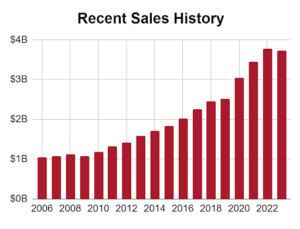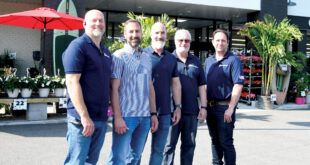For Orgill’s finance department, the last 10 years have been a journey of calculated risks, strategic foresight and commitment to fiscal excellence. Spearheaded by Orgill’s chief financial officer Eric Divelbiss, alongside senior vice president of accounting Jodi Fontana and vice president of accounting Erica Wilhite, the Orgill finance team has been navigating the ever-changing hardware and retail markets to secure Orgill’s position as a leader in the retail and distribution sectors.
 “Our financial road map over the past decade was designed to fuel growth and innovation,” Divelbiss says. “The strategic deployment of resources into technology and infrastructure has been pivotal. Investing in systems like the Salesforce customer relationship management product for our sales team and robotics at our distribution centers has not only enhanced our operational efficiency, but also has helped increase our market penetration.”
“Our financial road map over the past decade was designed to fuel growth and innovation,” Divelbiss says. “The strategic deployment of resources into technology and infrastructure has been pivotal. Investing in systems like the Salesforce customer relationship management product for our sales team and robotics at our distribution centers has not only enhanced our operational efficiency, but also has helped increase our market penetration.”
Orgill’s revenue growth, which includes the integration of new customers and markets, has been a highlight of the company’s collective effort, Fontana says.
“Expanding our customer base while enhancing value for our existing clients has been a cornerstone of our strategy,” Fontana says. “The implementation of programs like SmartStarts and the addition of new stores have been instrumental in driving our growth targets.”
Market expansions has been another focal point of Orgill’s financial strategy. The company has invested approximately $230 million in infrastructure, including the expansion of the Hurricane distribution center in Utah and the construction of the state-of-the-art Tifton distribution center in Georgia.
“These investments are not just about expanding our physical footprint,” Wilhite says. “They’re about embracing innovation and setting new benchmarks for efficiency and productivity throughout the company.”
Addressing financial challenges has been commonplace for the finance department. Fluctuating interest rates and rising fuel prices posed significant hurdles, but strategic financial hedging and an agile approach to capital allocation allowed the finance department to mitigate these impacts effectively, Divelbiss says.
“Our finance team’s ability to adapt and respond to these challenges has been key to maintaining our financial health and ensuring continuous growth,” Divelbiss says.
Strategic emphasis on performance metrics such as gross margin return, sales growth and inventory turnover has been critical in steering Orgill’s financial direction.
“These metrics are not just numbers,” Wilhite says. “They provide us a means to closely monitor our operational efficiency, market responsiveness and the hard work of every Orgill team member.”
Looking forward, goals include doubling industry growth annually and improving inventory turnover by the company.
“The expansion into new markets, like the farm and ranch sector, represents our commitment to growth and exploration,” Fontana says. “Leveraging our investments in infrastructure to reduce our cost structure further is also a key focus.”
Reflecting on the past decade, the lessons learned are clear: staying aligned with the mission to help customers succeed and fostering a culture of continuous improvement are paramount, Divelbiss says.
“These principles have guided our financial strategies and will continue to be our compass as we navigate the future,” he says.
 Hardware Retailing The Industry's Source for Insights and Information
Hardware Retailing The Industry's Source for Insights and Information








